Algebraic Expressions And Identities Addition And Subtraction Of Algebraic Expressions
While adding (or subtracting) polynomials, first look for like terms and add (or subtract) them; then handle the unlike terms. Note that the sum of x number of like terms is another like term whose coefficient is the sum of the coefficients of the like terms being added.
Addition And Subtraction Of Algebraic Expressions Exercise 8.1
Question 1. Add the following.
xb – bc, bc – cx, cx – xb
x – b + xb, b – c + be, c – x + xc
2p2q2 – 3pq + 4, 5 + 7pq – 3p2q2
l2 + m2, m2 + n2 n2 + l2, 2lm + 2mn + 2nl
Read and Learn More NCERT Solutions For Class 8 Maths
Solution: 1. xb – bc, bc – cx, cx – xb
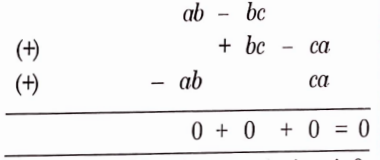
Thus, the sum of the given expressions is 0.
2. x-b + xb, b-c + bc, c-x+xc
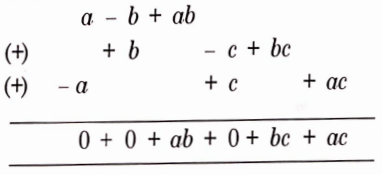
Class 8 Maths Algebraic Expressions and Identities
Thus, the sum of the given expressions is ab + bc + cx
3. 2p2q2 – 3pq + 4, 5 + 7pq – 3p2q2

4. l2 + m2, m2 + n2, n2 + l2, 2lm + 2mn + 2nl
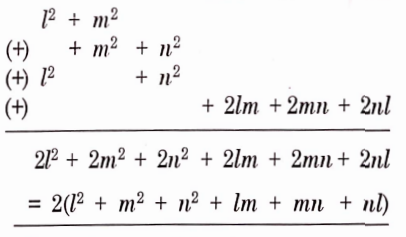
Thus, the sum of the given expressions is 2(l2 + m2 + n2 + Im + mn + nl).
Question 2.
- Subtract 4x – 7xb + 3b + 12 from 12x – 9xb + 5b – 3
- Subtract 3xy + 5yz – 7zx from 5xy – 2yz – 2zx + lOxyz
- Subtract 4p2q – 3pq + 5pq2 – 8p + 7q – 10 from IS – 3p – 11q + 5pq – 2pq2 + 5p2q
Solution:
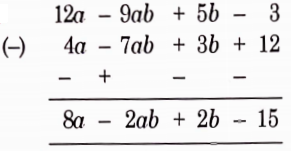
Thus, the required answer is 8a – 2ab + 26- 15

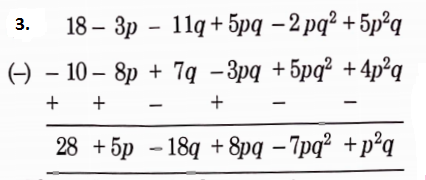
Thus, the required answer is 28 + bp- 18q + 8pq- Ipq2 + p2q
Algebraic Expressions Class 8 Solutions
8.2 Multiplication Of Algebraic Expressions: Introduction
There exist x number of situations when we need to multiply algebraic expressions. For example, in finding the xerox of x rectangle whose sides are given xs expressions
Question 1. Can you think of two more such situations, where we may need to multiply algebraic expressions?
[Hint: Think of speed and time; Think of interest to be paid, the principal and the rate of simple interest; etc.].
Solution:
Distance = Speed x Time
Simple Interest
Principal x Rate of simple interest
⇒ \(=\frac{\text { per annum } \times \text { Time in years }}{100}\)
Multiplying A Monomial By A Monomial
A monomial multiplied by an x monomial always gives an x monomial.
Multiplying Two Monomials
In the product of two monomials
Coefficient = coefficient of first monomial x coefficient of second monomial
Algebraic factor – algebraic factor of first monomial x algebraic factor of second monomial
Multiplying Three Or More Monomixls
We first multiply the first two monomials and then multiply the resulting monomial by the third monomial. This method can be extended to the product of any number of monomials.
Rules Of Signs
(1) The product of two factors is positive or negative accordingly xs the two factors have like signs or unlike signs. Note that
- (+) x (+) = +
- (+) X (-) = –
- (-) x (+) = –
- (-) x (-) = +
(2) If x is x vxrixble xnd p, q xre positive inteqers, then
xp x xq = xp+q
Class 8 Maths Chapter 8 Question Answer
Question 1. Find 4x x 5y x 7z. First, find 4x x 5y and. multiply it by 7z; or first, find 5y x 7z and multiply it by 4x. Is the result the same? What do you observe? Does the order in which you carry out the multiplication matter?
Solution:
4x x 5y x 7z
4x x 5y = (4 x 5) x (x x y)
= 20 x (xy) = 20 xy
(4x x 5y) x 7z = 20xy x lz
= (20 x 7) x (xy x z)
= 140 x (XYZ)
= 140xyz …(1)
OR
5y x 7z = (5 x 7) x (y x z)
– 35 X (yz) = 35yz
4x X (5y X 7z) = 4x X 35yz
= (4 x 35) x (x x yz)
= 140 x (xyz)
= I40xyz…..(2)
We observe from Eqns. (1) and (2) that the result is the same. It shows that the product of monomials is associative, i.e., the order in which we multiply monomials does not matter.
Addition And Subtraction Of Algebraic Expressions Exercise 8.2
Question 1. Find the product of the following pairs of monomials:
- 4, 7p
- -4p, 7p
- -4p, 7pq
- 4p3, -3p
- 4p, 0.
Solution:
(1) 4, 7p
4 x 7p = (4 x 7) x p
= 28 x p
= 28p
(2) – 4p, Ip
(-4p)x(7p) = {(-4) x 7} x (P x P)
= (-28) x p2
= -28p2
(3) -4p, 7pq
(- 4p) x (Ipq) = {(- 4) x 7} x (p x (pq)}
= (-28) x (p x p x q)
= (-28) x p2
= -28p2q
(4) 4p2, – 3p
(4p3) x ( -3p) = {4 x (_ 3)} x (p3 Xp)
= (-12) X p4
= – 12p4
(5) 4p, 0
(4p) x 0 = (4×0) x p
0 x p = 0
Class 8 Maths Chapter 8 Exercise Solutions
Question 2. Find the press of rectangles with the following pairs of monomials xs their lengths and breadths respectively:
(p, q) ; (10m, 5n); (20x2 5y2); (4x, 3.x2); (3mn, 4np).
Solution:
1. (p, q)
Length = p
Brexdth = q
Area of the rectangle
= Length x Brexdth
= P x q
= pq
2. (10m, 5n)
Length = 10 m
Brexdth = 5 n
Area of the rectangle
= Length x Brexdth
= (10m) x (5n)
= (10 x 5) x (m x n)
= 50 x (mn)
= 50 mn
3. (2Ox2 , 5y2)
Length = 20X2
Brexdth = 5y2
Area of the rectangle
= Length x Brexdth
= (20x2) x (5y2)
= (20 x 5) x (x2 x y2)
= 100 x (x2/)
= 100x2y2
4. (4x,3x2)
Length = 4x
Brexdth = 3X2
Area of the rectangle
= Length x Brexdth
= (4x) x (3x2)
= (4 x 3) x (x x x2)
= 12 x x3 = 12X3
CBSE Class 8 Algebraic Expressions and Identities
5. (3mn, 4np)
Length = 3mn
Brexdth = 4np
Area of the rectangle
= Length x Brexdth
= (Smn) x (4np)
= (3×4) x (mn) x (np)
= 12 x m x (n x n)xp
= 12 mn2p.
Question 3. Complete the table of products.
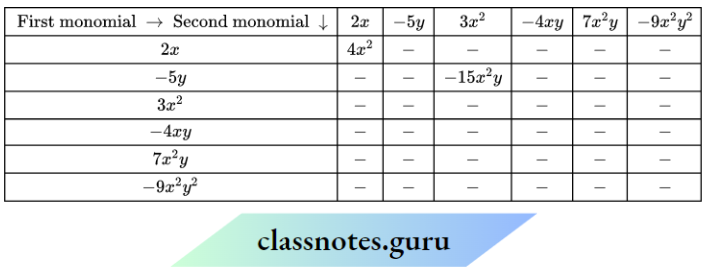
Solution:
We have.
1. 2x x -5y = {2 x (- 5)} x (x x y) = – lOxy
2x x 3X2 = (2 x 3) x (x x x2) = 6X3
2x x (- 4xy) = {2 x (-4)} x x x (xy)
= -8 X (x X x) X y
= – 8 x2y
2x X 7x2y = (2 X 7) X (x X x2) x y = 14x2y
2x x (-9X2y2) = {2 x (-9)> x (x x x2) Xy2
= – 18x3y2
2. (-5y)x(2x)
= {(-5) x 2} X (y X x)
= – 10 xy
(- 5y) x (- 5p)
= {(-5) x (-5)} x y xy
= 25 y2
(~5y) x 3X2
= {(-5) x 3} x yx2
= – 15.x2y
(-5y) x ( – 430’)
= {(-5) X (- 4)} x XX (y X y)
= 20 xy2
(-5y) x (7x2y)
= {(-5) X 7} X x2 X (yXy)
= -35 x2y2
(~5y) x (-qx2ÿ)
= {(-5) x (- 9)} x x2x(yxy2)
= 45 x2y3
Algebraic Identities Class 8 Explanation
3. 3x2 x 2x = (3 x 2) x (x2 x x) = 6X2
3X2 x 3x2 = (3 x 3) x (x2 x x2) = 9 x4
3x4 x (- 4 xy) = 3 x (- 4)} x (x2 x x) x y = – 12x3y
3x2 x 7x2y
= (3 x 7) x (x2 x x1) xy
= 21×4
3x2 x (- 9X2 y2)
= {3 x (- 9)} x (x2 x x2)xy2
= – 27xy
4. (-4xy) x 2x
= {(_4) x 2} x {x x x) xy
= -8x2y
(-4xy) x (-5y)
= {(- 4) x (- 5)} X X x (y x y)
= 20xy2
(-4x2y) x 3X2
= {(- 4) x 3} x (ix x2) x y
= – 12x2y
(-430) x (- 4xy)
= {(-4) X (_4)}x (ixi)x(y Xy)
= 16x2y2
(-4xy) X Ixÿy
= {(-4) X 7} X (x X X2) X (y X y)
= -28x3y2
(- 4xy) X (- 9X2)
={(-4) x (-9)} X (x X x2) X (y X y2)
= 36x3y3
5. 7x2y x 2x
= (7 x 2) x (x2 x x) x y
= 14x2y
7x2y x (- 5y)
= {7 x (-5)} x x2 X (y Xy)
= – 35x2y2
7x2y X(3x2)
– (7 x 3) X (*2 x x2) Xy = 21x4y
7x2y x (- 4 xy)
= {7 X (-4)} X (x2 x x) X (y X y)
= -28x3y2
7x2y x 7x2p
= (7 x 7) X (x2 X X2) x (y X y)
= 49x4y2
7-X2y X (_ 9x2ÿ2)
= {7X(-9)} X (x2X X2) X (y x y2)
= -63x4y3
(- 9x2,y2) x 2x
= {(-9) x 2} x x( x x) x y2
= -18x3y2
(-9xV) x (-5y)
= {(-9) x (-5)} x x2 x x2 (y2x y)
– 45x2y3
(- 9x2y2) x (3X2)
= {(- 9) x 3} x (x2 x x2) x y2
= – 27x4 y2
(- 9x2y) x (- 4xy)
= {(-9) x (-4)} x (x2 x X) x (y2 x y)
= 36 x4
(~9x2y2) x (7x2y)
= {(-9)x7}x(x2Xx2)X(y2xy)
= – 63 xy
(-9x2y2) x (- 9xY)
= {(-9) x (-9)}x ft? xÿ x (y2 x y2)
= 81 x4y4

Class 8 Maths Chapter 8 Examples with Solutions
Question 4. Obtain the volume of rectangular boxes with the following length, breadth, and height respectively:
- 5x, 3x2, 7x.4
- 2p, 4q, 8r
- xy, 2x2y, 2xy2
- x, 2b, 3c.
Solution:
1. 5x, 3x2, 7×4
Length = 5x
Brexdth = 3x2
Height = 7×4
Volume of the rectangular box
= Lenqth x Breadth x Heiqht
= (5x) x (3x2) x (7×4)
= (5 x 3 x 7) x (x x x2 x x4)
= 105×7
2. 2p, xq, 8r
Lenqth = 2p
Brexdth = xq
Heiqht = 8r
Volume of the rectxnqulxr box
= Lenqth x Brexdth x Heiqht
= (2p) x (xq) x (8r)
= (2 x 4 x 8) x (p x q x r)
= 64 pqr
3. xy, 2x2y, 2xy2
Length = xy
Brexdth = 2x2y
Height = 2xy2
The volume of the rectangular box
= Length x Breadth x Height
= (xy) x (2x2y) x (2xy2)
= (2 x 2) x (x x x2 x x) x (yxyxy2)
= 4x4y4
4. x, 2b, 3c
Length = x
Brexdth = 2b
Height = 3c
The volume of the rectangular box
= Length x Breadth x Height
= (x) x (2b) x (3c)
= (2 x 3) x (x x b x c)
= 6xbc
Question 5. Obtain the product of
- xy, yz, zx
- x, -x2, x3
- 2, 4y, 8y2, 16y3
- x, 2b, 3c,6xbc
- m, -mn, mn
Solution:
1. xy, yz, zx
Required product
= (xy) x (yz) x (zx)
= (x x X) X (y X y) X (Z X z)
= x2 x x 2z2
= x22y2z2
2. x, -x2, x3
Required product
= (x) x (-x2) x (x2)
= – (x x x2 x x3)
= -x6
3. 2, 4y, 8y2 16y3
Required product
= (2) x (4y) x (8y2) x (16y3)
= (2 x 4 x 8 x 16) x (y x y2 x y3)
= 1024y6
4. x, 2b, 3c, 6xbc
Required product
= (x) x (26) x (3c) x (6xbc)
= (2 x 3 x 6) x (x x x) x (6 x 6) x(c x c)
= 36 x2b2c2
5. m, – mn, mn
Required product
= (m) x (-mn) x (mnp)
= (- 1) x (m x m x m) x (n xn) xp
= -m2n2p
NCERT Solutions for Class 8 Maths Chapter 8
Multiplying A Monomial By A Polynomial
While multiplying x polynomial by x monomial, we multiply every term in the polynomial by the monomial.
Using the distributive law, we carry out the multiplication term by term.
It states that if P, Q, and R are three monomials, then
- P x (Q + R) = (P x Q) + (p x R)
- (Q + R) x p = (Q x P) + (R x P)
Question. Find the product:
1. 2x(3x + 5xy) (H)x,2 (2xb – 5c).
Solution:
1. 2x (3x + 5ry)
2x (3x + 5xy) = (2x) x (3x) + (2x) x (5xy)
= (2 x 3) x(xxx) + (2 x 5) x (x x x) x y
= 6x2 + 10 x2y
2. a2 (2xb-5c)
x2(2xb – 5c) = (x2) x (2xb) – (x2) x (5C)
= (1 x 2) x (x2 x x) X b -(1 X 5) X x2 X c
= 2a3b – 5a2c
8.4.2 Multiplying A Monomial By A Trinomial
By using the distributive law, we carry out the multiplication term by term
Question. Find the product: (4p2 + 5p + 7) x 3p.
Solution:
(4p2 + 5p + 7) x 3p.
= (4p2x 3p) + (5p x 3p)+ (7 x 3p)
= (4 x 3) x (p2 x P) + (5 x 3) x (p x p) + (7 x 3) x p
= 12p3+ 15p2 + 21p
Addition And Subtraction Of Algebraic Expressions Exercise 8.3
Question 1. Carry out the. multiplication of the expressions in exch for the following pairs:
- 4p, q + r
- ab, a – b
- a + b, 7a2b2
- a2-9, 4a
- PQ + qr + rp, 0
Solution:
1. 4p, q + r
(4p) x (q+ r) = (dp) x (q) + (4 p) x (r)
By distributive law
= (4 x 1) x p x q + (4 x 1) x p x r
= 4pq + 4pr
(2) xb, x-b
(ab) x (a-b) = (ab) x (a) – (ab) x (b)
By distributive law
= (1 x 1) x (a x a) xb
– (1 x 1) a x (b x b)
= a2b – ab2
3. a+b, 7a2b2
(x +b) x (7a2b2)
= x x 7a2 b2 + 5 x 7×2 b2
By distributive law
= (1 x 7) x (a x x2) x b2 + (1 x 7) x a2 x (a x b2)
= 7a3b2 + 7a2b3
a2– 9, 4a
(a2– 9) x (4a)
= a2x 4a – 9 x 4a
By distributive law
= ( 1 x 4) x (a2 x a) – (9 x 4) x a
= 4a3-36a
PQ + qr + rp, 0
(PQ + qr+ rp) x (0)
= (pq) x 0 + (qr) x 0 + (rp) x 0.
By distributive law
= 0 + 0 + 0 = 0.
Class 8 Chapter 8 Maths NCERT Solutions PDF
Question 2. Complete the table:

Solution:
We have,
(1) a x (b + c + d)
= a x b + a x c + a x d
= ab + ac + ad
(2) (X + y – 5) x 5xy
= pC x 5pc_y + y x 5*y + (-5) x 5xy
= (1 X 5) X (x x X) X y
+ (1 x 5) X X X (y X y)
+ {(-5) x 5}x xy
= 5x2y + 5xy2 – 25xy
(3) p x (6p2 – 7p + 5)
= p x 6p2 + p x (- 7p) + p x 5
= (1 x 6) x (p xp2)
+ {1 x (- 7)} x (p x p) + 5 x p
= 6p3 – 7p2 + 5p
(4) 4p2q2 x (p2 – q2)
= 4p2q2 x p2 + 4p2q2 x (-q2)
= (4 x 1) x (p2 x p2) x q2
+ {4 X (- 1)} X p2 X (q2 X q2)
= 4p4 q2 – 4p2 q4.
(5)(a + b + c) x abc
= a x abc + b x abc + c x abc
= (ax a) x b x c
+ a x (b x b) x c
+ a x b x (c x c)
= a2 bc + ab2 c + abc2

Question 3. Find the product:
(a2) x(2a22) x (4a26)
⇒ \(\left(\frac{2}{3} x y\right) \times\left(\frac{-9}{10} x^2 y^2\right)\)
⇒ \(\left(-\frac{10}{3} p q^3\right) \times\left(\frac{6}{5} p^3 q\right)\)
x x x2 x x3x x4
Solution. (1) (x2) x (2x22) x (4x26)
= (1 x 2 x 4) x (x2 x x22 x x26)
= 8 X a2+22+26
By laws of exponents
= 8 x a50 = 8 x 50
⇒ \(\left(\frac{2}{3} x y\right) \times\left(-\frac{9}{10} x^2 y^2\right)\)
⇒ \(\left\{\frac{2}{3} \times\left(-\frac{9}{10}\right)\right\} \times\left(x \times x^2\right) \times\left(y \times y^2\right)\)
⇒ \(-\frac{3}{5} x^3 y^3\) I by laws of exponents
3. \(\left(-\frac{10}{3} p q^3\right) \times\left(\frac{6}{5} p^3 q\right)\)
⇒ \(=\left\{\left(-\frac{10}{3}\right) \times \frac{6}{5}\right\} \times\left(p \times p^3\right) \times\left(q^3 \times q\right)\)
= -4p4q4. By laws of exponents
(4) X x x2 X x3 X x4
X x x2 x x3 X x4 = (1 X 1 X 1 X 1) X X1 X x2 X x3 X x4
= (1) X x 1+2+3+4
= X10.
By laws of exponents
Question 4. (a) Simplify: 3x (4x -5) +3 and find us values for (1) x = 3, (2) x =\(\frac{1}{2}\)
(b) Simplify: x(x2 + x + 1) + 5 xnd find its value for
(1) x = 0, (2) x = 1 and (3) x = -1.
Solution :
1. 3x (4x-5) + 3
= (3x) (xx) – (3x) (5) + 3
= (3 x 4) x (x x x) – (3 x 5) x x + 3
= 12x2 – 15x + 3
(i) When x = 3,
12x2 – 15.x + 3
= 12(3)2 – 15(3) + 3
= 12 x 9 – 45 + 3
= 108 – 45 + 3 = 66
2. When x =\(\frac{1}{2}\)
12X2 – 15.x + 3
⇒ \(12\left(\frac{1}{2}\right)^2-15\left(\frac{1}{2}\right)+3\)
⇒ \(12\left(\frac{1}{4}\right)-\frac{15}{2}+3\)
⇒ \(3-\frac{15}{2}+3\)
⇒ \(6-\frac{15}{2}\)
⇒ \(\frac{12-15}{2}\)
⇒ \(-\frac{3}{2}\)
(b) a(a2 + x + 1) + 5
a x a2 + a x a + (a x 1 + 5 )
= a3 + a2 + a+ 5
1. When a = 0
a3 + a2+ a + 5 = (0)3 + (0)2 + (0) + 5
=0+0+0+5=5
2. When a =1
a3 + a2 + a+ 5 = (l)3 + (l)2 + (1) + 5
=l+l+l+5=8
3. When a=-l
a3 +a2 + a+ 5
= (- 1)3 + (- l)2 + (- 1) + 5
= —1 + 1 — 1 + 5 = 4
Class 8 Maths Algebraic Expressions and Identities
Question 5.
- add : p(p – q), q(q – r) and r(r-p)
- add: 2x(z – x – y)and 2y (z -y- x)
- Subtract: 31 (l – 4m. + 5n) from 41 (10n-3m + 21)
- Subtract: 3x(x +b+c)-2b(x-b+c) from 4c(- x + b+ c).
Solution:
(1) First expression
= p(p-q)=pxp-pxq
= p2 – pq
Second expression
= q(q-r)
= q x q – q x r
= q2 – qr
Third expression
= r(r – p)
=r x r – r x p
= r2 – rp
adding the three expressions,
image
First expression
= 2x (z – x – y)
= (2x) X (2)-(2x) X (x) – (2x) X (y)
= 2xz -2x2 – 2xy
Second expression
= 2y(z-y-x)
= (2y) x (z) – (2y) x (y) – (2y)x(x)
= 2yz – 2y2 – 2yx
adding the two expressions,
image
First expression
= 31(1 – 4m + 5n)
= (31) x (l) – (31) x (4m) + (31) x (bn)
= 312 – 12lm + 15In
Second expression
= 41 (10n – 3m + 2l)
= (41) x (10n) – (4l) x (3m) + (4l) x (2l)
= 40ln – 12lm + 8l2
Subtracting,
image
First expression
= 3x (x + 6 + c) – 26 (x – 6 + c)
= [(3x) x (x) + (3x) x (6) + (3x) x (c)]
-[(26) x (x) + (26) x (6) – (26) x (c)]
= [3a2 + 3ab + 3ac]- [2ab- 2b2 + 2bc]
= 3a2 + 2b2 + 3ab – 2ab- 2bc + 3ac
– 3a2 + 2b2 + ab- 2bc + 3ac
Second expression
= 4c (- x + 6 + c)
= 4c x (-x) + 4c x 6 + 4c x c
= -4xc + 46c + 4c2
Subtracting
image
8.5 Multiplying A Polynomial By A Polynomial
We multiply the term of one polynomial by each term of the other polynomial. Also, we combine the like terms in the product.
Multiplying A Binomial By A Binomial
We use distributive law and multiply each of the two terms of one binomial by exchanging the two terms of the other binomial and combining like terms in the product.
Thus, if P, Q, R, and S are four monomials, then
(P + Q) x (R + S) = P x (R + S) +Qx(R + S)
= (P x R + P x S) + (QXR + QXS)
= PR + PS + QR + QS.
8.5.2 Multiplying A Binomial By A Trinomial
We use distributive law and multiply each of the three terms in the trinomial by exchanging the two terms in the binomial and combining like terms in the product.
Addition And Subtraction Of Algebraic Expressions Exercise 8.4
Question 1. Multiply the binomial:
- (2x + 5) and (4x – 3)
- (y – 8) and (3y – 4)
- (2.51 – 0.5 m) and (2.51 + 0.5m)
- (x + 3b) and (x + 5)
- (2pq + 3q2) and (3pq – 2q2)
- \(\left(\frac{3}{4} x^2+3 b^2\right) \text { and } 4\left(x^2-\frac{2}{3} b^2\right)\)
Solution:
(i) (2x + 5) xnd (4x – 3)
(2x + 5) x (4x – 3)
= (2x) x (4x – 3) + 5 x (4x – 3) by distributive law
= (2x) x (4x) – (2x) x (3) + (5) x (4x) – (5) x (3)
= 8x2 – 6x + 20x – 15
= 8x2 + (20x – 6x) – 15 Combining like terms
= 8x2 + 14x – 15
2. (y – 8) and (3y – 4) by distributive law
(y – 8) x (3y – 4)
= y x (3y – 4) – 8 x (3y – 4) – (8) x (3y) + 8 x 4
= (y) x (3y) – (y) x (4)
= 3y2 – 4y -24y + 32 Combining like terms
3. (2.5 l – 0.5 m) xnd (2.5 l + 0.5 m)
(2.5 l – 0.5 m) x (2.5 l + 0.5 m)
= (2.5 l) x (2.5 l + 0.5 m) – (0.5 m) x (2.5 l + 0.5 m) by distributive law
= (2.5 Z) x (2.5 Z) + (2.5 l) x (0.5 m) – (0.5 m) x (2.5 l) – (0.5 m) x (0.5 m)
= 6.25 12 + 1.25 Zm – 1.25 m/- 0.25 m2 Combining like terms
= 6.25 l2 + (1.25 lm – 1.25 lm) – 0.25 m2
= 6.25 l2 – 0.25 m2
4. (x + 3 b) and (x + 5)
(a + 35) x (x + 5)
= a x (c +5) + (3b) x (x + 5) by distributive law
= (a) x (x) + (a) x (5) + (3b) x (x) + (3b) x (5)
= ax + 5a + 3bx + 15b
5. (2pq + 3q2) and (3pq – 2q2)
(2pq + 3q2) x (3pq – 2q2)
= (2pq) x (3pq – 2q2) + (3q2) x (3pq – 2q2) by distributive law
= (2pq) x (3pq) – (2pq) x (2q2) + (3q2) x (3pq) – (3q2) x (2q2)
= 6p2q2 – 4pq3 + 9pq3 – Qqi
= 6p2q2 + (9pq3 – 4pq3) – 6q4 Combining like terms
= 6p2q2 + 5pqz – 6q4
⇒ \(\left(\frac{3}{4} x^2+3 b^2\right) \text { and } 4\left(x^2-\frac{2}{3} b^2\right)\)
⇒ \(\left(\frac{3}{4} x^2+3 b^2\right) \times 4\left(x^2-\frac{2}{3} b^2\right)=\left(\frac{3}{4} x^2+3 b^2\right) \times\left(4 x^2-\frac{8}{3} b^2\right)\)
⇒ \(\frac{3}{4} x^2 \times\left(4 x^2-\frac{8}{3} b^2\right)+3 b^2 \times\left(4 x^2-\frac{8}{3} b^2\right)\) by distributive law
⇒ \(\left(\frac{3}{4} x^2\right) \times\left(4 x^2\right)-\left(\frac{3}{4} x^2\right) \times\left(\frxc{8}{3} b^2\right)+\left(3 b^2\right) \times\left(4 x^2\right)-\left(3 b^2\right) \times\left(\frac{8}{3} b^2\right)\)
= 3a4 – 2a2b2 + 12b2a2 – 8b4
= 3a4 + (12a2b2 -2a2b2) -8b4
= 3a4 + 10a2b2 – 8b4Combining like terms
Question 2. Find the product:
- (5 – 2x) (3 + x)
- (x + 7y) (7x-y)
- (x2 + b) (x + b2)
- (p2 – q2) (2p + q)
Solution:
(i) (5 – 2x) (3 + x)
= (5) x (3 + x) – (2x) x (3 + x)
= (5) x (3) + (5) x (x) – (2x) X (3) – (2x) X (X)
= 15 + 5x – 6x – 2x2
= 15 – x – 2x2
2. (x + 7y) (7x – y)
= (x) x (7x – y) + (7y) x (7x – y)
= (x) x (7x) – (x) x (y) + (7y) x (7x) – (7y) x (y)
= 7x2 – xy + 49yx – 7y2
= 7x2 + 48xy – 7y2
3. (a2 + b) (a + b2)
= a2 x (a+ b2) + b x (a + b2)
= (a2) x (a) + (a2) x (b2) + (b) x (a) + (b) x (b2)
= a3 + a2b2 + ab + b3
= a3 + a2b2 + ab + b3
4. (p2 – q2) (2p + q)
= p2 x (2p + q) – q2 x (2p + q)
= (p2) x (2p) + (p2) x (q) – (q2) x (2p)- (q2) x (q)
= 2p3+ p2q – 2q2p – q3
= 2p3 + p2q – 2pq2 – q3
Class 8 Maths Chapter 8 Question Answer
Question 3. Simplify :
- (x2 – 5) (x+ 5) + 25
- (x2 + 5) (b3 + 3) + 5
- (l + s2) (l2 – s)
- (x + b)(c – d) + (x – 6) (c + d)+ 2 (xc + bd)
- (x + y) (2x + y) + (x + 2y)(x – y)
- (x + y) (x2 – xy + y2)
- (1.5x – 4y)(1.5x + 4y + 3)- 4.5x + I2y
- (x + b + c) (x. + b – c).
Solution:
1. (x2 – 5) (x + 5) + 25
= x2(x + 5) – 5(x + 5) + 25
= (x2 x X) + (x2 x 5) – (5 x X) – (5 x 5) + 25
= x3 + 5X2 – 5x – 25 + 25
= x3 + 5×2 – 5x
2. (a2 + 5) (b3 + 3) + 5
= a2(b3 + 3) + 5(b3 + 3) + 5
= (a2 x b3) + (a2 x 3) + (5 x b3) +(5a3) + 5
= a2b3 + 3a2 + 5b3 + 15 + 5
= a2b3 + 3a2 + 5b3 + 20
3. (t + s2) (t2 – s)
= t(t2 – s) + s2(t2 – s)
= (tx t2) – (t X s) + (s2 X t2) – (s2 X s)
= t2 -ts + s2t2 – s3
4. (a + b) (c – d) + (a – b) (c + d) + 2(ac + bd)
= a(c – d) + b(c – d) + a(c + d) – b(c + d) + 2(oc + bd)
= ac – ad + be – bd + ac + ad – be – bd + 2ac + 2bd by distributive law
= (ac + ac + 2ac) + (ad- ad) + (be- be) + (2bd – bd – bd)
= 4ac combines the like terms
5. (x + y) (2x + y) + (x + 2y) (x – y)
= x(2x + y) + y(2x + y) + x(x – y) + 2y(x – y)
= (X X 2x) + (x X y) + (y X 2x) + (y x y) + (x x x) – (x X y) (2y x x)- (2y x y
By distributive law
– 2×2 + xy + 2xy + y2 + x2 – xy + 2xy – 2y2
= (2x2 + x2) + (xy + 2xy – xy + 2xy) + (y2 – 2y2)
= 3x2 + 4xy – y2
6. (x + y) (x2 – xy + y2)
x(x2 – xy + y2)= y(x2 – xy + y2)
(x x x2) – (x x xy) + (x x y2) + (y x x2) – (y x xy) + (y x y2 ) | by distributive law
x3 – x2y + xy2 + x2y – xy2 + y3
= x-3 + x2y – x2y) + (xy2 – xy2) + y3 combining the like terms
= x–3 + y2
7. (1.5x – 43-) (1.5x + 4y + 3) – 4.5x + 12y
= 1.5x (1.5x + 4y + 3)- 4y (1.5x + 4y + 3) – 4.5x + 12y | by distributive law
= (1.5x x 1.5x) + (1.5x x 4y) + (1.5x X 3) – (4y x 1.5x) – (4y x 4y) – (4y x 3) – 4.5x + 12y | by distributive law
2.25x2 + 6xy + 4.5x – 6xy – 16y2 – 12y – 4.5x + 12y
= 2.25x2 + (6xy – 6xy) – 16y2 + (4.5x – 4.5x) + (12y – 12y) I combining the like terms
= 2.25x2 – 16y2
8. (a + b + c) (a + b – c)
= a(a + b-c) + b(a + b-c) + c(a + 6-c) I by distributive law
= a2 + ab – ac + ab + b2 – be + ae + be – c2 I by distributive law
= a2+ (ab + ab) + (ac – ac) + b2 + (be – be) – c2 combining the like terms
= a2 + 2ab + b2 – c2
Addition And Subtraction Of Algebraic Expressions Multiple-Choice Questions And Solutions
Question 1. The expression x + 3 is in
- one variable
- two variables
- no variable
- none of these.
Solution: 1. one variable
Question 2. The expression 4xy + 7 is in
- one variable
- two variables
- no variable
- none of these.
Solution: 2. two variables
Algebraic Identities Class 8 Explanation
Question 3. The expression x + y + z is in
- one variable
- no variable
- three variables
- two variables.
Solution: 3. three variables
Question 4. The value of 5x when x = 5 is
- 5
- 10
- 25
- -5.
Solution: 3. 25
Question 5. The value of x2 – 2x + 1 when x = 1 is
- l
- 2
- -2
- 0.
Solution: 4. 0
Question 6. The value of x2 + y2 when x = 1, y = 2 is
- l
- 2
- 4
- 5.
Solution: 4. 5
Question 7. The value of x2 – 2yx + y2 when x = 1, y = 2 is
- l
- -l
- 2
- -2.
Solution: 1. 1
Question 8. The value of x2 – xy + y2 when x = 0, y = 1 is
- 0
- -l
- l
- none of these.
Solution: 3. 1
Question 9. The sum of lx, lOx, and 12x is
- 17x
- 22x
- 19x
- 29x.
Solution: 4. 29x.
Question 10. The sum of 8pq and -17pq is
- pg
- 9pqr
- -9pq
- -pg.
Solution: 3.-9pq
Question 11. The sum of 5x2, -7X2, 8x2, 11x2 and -9x2 is
- 2x2
- 4x2
- 6x2
- 8x2
Solution: 4. 8x2.
Question 12. The sum ofx2 y2-z2 and z2-x2 is
- 0
- 3x2
- 3y2
- 3z2
Solution: 1. 0
Question 13. What do you get when you subtract – 3xy from 5xy?
- 3xy
- 5xy
- 8xy
- xy.
Solution: 3. 8xy
Question 14. The result of the subtraction of law from 0 is 4
- 0
- 7x
- -7x
- x
Solution: 3. -7x
Class 8 Maths Chapter 8 Examples with Solutions
Question 15. The result of subtraction of 3x from – 4x is
- -7x
- 7x
- x
- -x.
Solution: 1. -7x
Question 16. The product of 4mn and 0 is
- 0
- 1
- mn
- 4mn.
Solution: 1. 0
Question 17. The product of 5x and 2y is
- xy
- 2×7
- 5xy
- 10xy.
Solution: 4. 10xy.
Question 18. The product of lx and -12x is
- 84x2
- -84x2
- x2
- -x2.
Solution: 2. -84x2
Question 19. The area of a rectangle whose length and breadth are 9 and 4y respectively is
- 4y3
- 9y3
- 36y3
- 13y3
Solution: 3. 36y3
Question 20. The area of a rectangle with length 2l2m and breadth 3Im? is
- 6l3m3
- l3m3
- 2l3m3
- 4l3m3
Solution: 1. 6l3m3
Question 21. The volume of a cube of side 2a is
- 4a3
- 2a
- 8a3
- 8.
Solution: 3. 8a3
Question 22. The volume of a cuboid of dimensions a, 6, c is
- abc
- a2b2c2
- a3b3c3
- none of these.
Solution: 1. abc
Question 23. The product of x2, – x3, – x4 is
- x9
- x5
- x7
- x6
Solution: 1. x9
Class 8 Maths Chapter 8 Exercise Solutions
Addition And Subtraction Of Algebraic Expressions True-False
Write whether the following statements are True or False:
1. In a polynomial, the exponents of the variables are always non-negative integers: True
2. a (b + c) = ab + ae is called the distributive property : True
3. a2 – b2 is the product of (a – b) and (a + b): True
Addition And Subtraction Of Algebraic Expressions Fill in the Blanks
1. The value of, when 92 -72 = 8p, is___________ : 4
2. On subtracting -a2b2 from 2ab2, we get___________: 2a2b2
3. The difference between the squares of two consecutive natural numbers is their_______: Sum
4. Area of a rectangle with length 3 ab2 and breadth 4 ac2 is_______: 12a2b2c2
5. Write the product of the monomials -12a, -15a2, a2b: 180 a3b3
6. Add a2 + b2 – c2 b2 + c2 – a2 and c2 + a2 – b2 : a2 + b2 + c2
7. Find the value of, if 1000y = (981)2 – (19)2: 962
